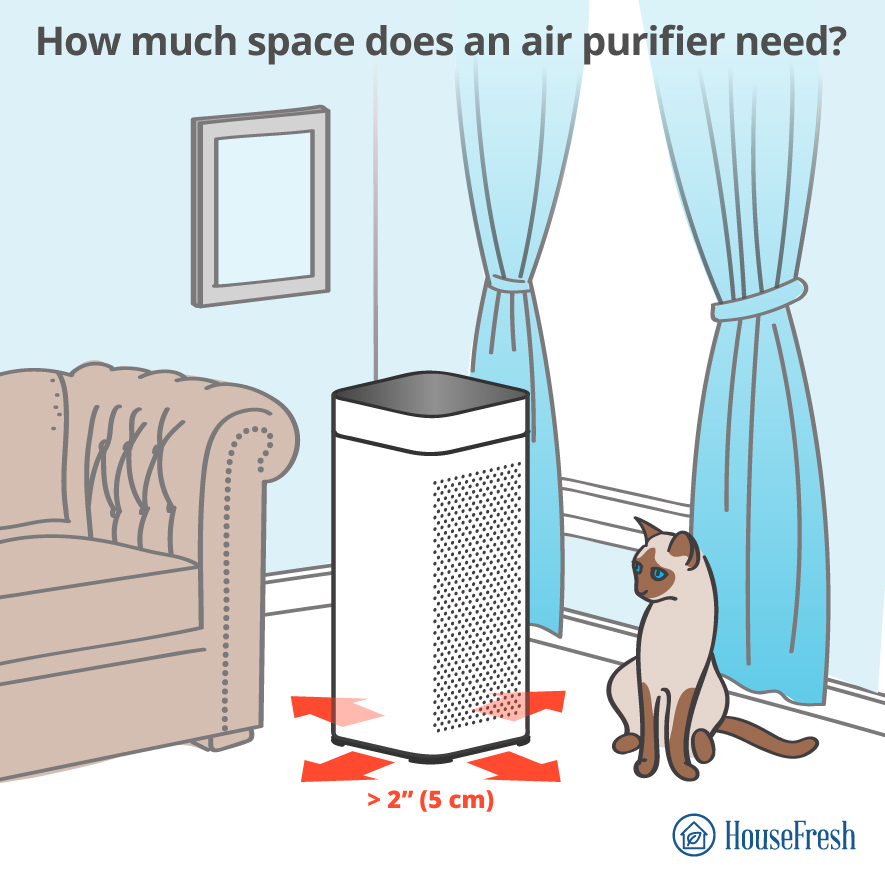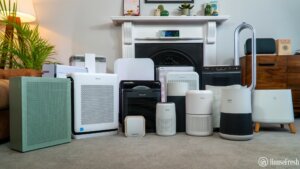If the air quality in your home isn’t ideal, an air purifier is essential. Not only do they remove airborne allergens that can make us (and our pets) miserable, but they also make our homes more comfortable and pleasant. They can even improve our health and sleep quality.
Like anything else, the effectiveness of your air purifier depends on if you’re using it properly. And one of the most important considerations is its placement. Having your air purifier in the wrong spot can significantly reduce its effectiveness and longevity.
Factors to keep in mind when placing an air purifier
You put a lot of research and thought into choosing an air purifier. The top considerations are usually the filter type and the size of your room. You should apply the same consideration when choosing a place for it, as putting an air purifier in the wrong spot can reduce its effectiveness.
Here are a few factors to consider:
1. Keep intake and outflow vents clear
Air purifiers work by drawing in your room’s air, filtering it to remove contaminants, and then blowing the purified air back out to circulate. For an air purifier to work properly, keep it away from walls or furniture so its intake and outflow vents aren’t blocked.
Obstructed vents will not only degrade performance but can damage the unit. Ideally, you should have a minimum of 2 in (around 5 cm) of clear space around the unit.

Although maximizing airflow for your air purifier will help it operate at peak efficiency, limit the amount of time you leave windows open in the room. Leaving them open for more than 20 minutes increases the amount of pollutants coming in.
2. Consider how high you put it
When placing an air purifier, elevate it so it’s about 4-5 feet off the ground in rooms where you primarily stand (like the kitchen), and 2-3 feet off the ground in rooms where you primarily sit or sleep (your bedroom). Keeping your air purifier at around the same height as your nose will maximize its effectiveness.
3. Keep away from heat and moisture
Like any other motorized device, excessive heat or moisture can damage the inner mechanisms of your air purifier and reduce its effectiveness. Or worse, cause it to malfunction. Avoid placing your purifier near heat sources or damp, humid areas.
Remember that other electronic devices can produce heat. Keep your air purifier away from televisions, computers, and other devices that can run hot.
4. Place near sources of smells and pollutants
Let’s say you have a conjoined kitchen and living room and also have a gas stove. You’ll want to place your air purifier somewhere in the kitchen and close to the gas source so that it can filter out pollutants immediately.
The closer you place your air purifier to the source, the more impact it has.
If there’s air pollution outside the house (e.g., wildfire smoke), it’s a good idea to switch your air conditioning unit to “recirculate mode” combined with your air purifier.
This mode stops taking in air from outside and reuses the purified air inside your home instead, reducing the contaminants that need to be removed.
What’s the advice from air purifier manufacturers?
It’s always wise to follow the advice of air purifier manufacturers, as they have a vested interest in helping you place your device properly.





In general terms, manufacturers advise to maximize airflow around the purifier and to think about the specific dimensions of the space where it’ll be used.
The companies that build air purifiers conduct a lot of research, test diligently, and make constant improvements to their products. They know what they’re talking about.
Wrapping up: The do’s and don’ts of air purifier placement
An air purifier can be a hefty investment, and if it’s not working as intended, then you’re wasting money.
These general guidelines can help you get the most bang for your buck:
What you should do
What you shouldn’t do
Like any other device, an air purifier will be most effective if you put a little strategic thought into its placement. The closer it is to the source of problems and the air you’re breathing while using the room, the more benefit you’ll get from the device.
- Kitchen: Target the middle of the room, and place it up on a counter. An island is the ideal spot. Don’t place it right next to any ventilation, like a hood vent, that can interfere with the purifier.
- Living room: If there’s a specific source of air pollution, place as close to it as possible (e.g. near a dog bed). Otherwise, place it as close to the middle of the room as possible, and elevate it so it’s at head level when people sit.
- Bedroom: Place your air purifier near your bed and at the same level as your mattress to ensure you breathe purified air all night.
- Home office: Place as near your workspace as possible. Elevate to match the position of your head (e.g. if you use a standing desk, raise the purifier to match).
- Basement: Basements tend to be damp and are often breeding grounds for mold. Target areas where there are signs of excess moisture — but keep in mind that an air purifier cannot eliminate mold. Mold will still need to be addressed separately.
SOURCES
- Airmega. Where should I place my air purifier? cowaymega.zendesk.com
- Alen. Alen Air Purifiers Best Practices. alen.com
- Cherney, K and Lamoreux, K. (2023). Do Air Purifiers Actually Work? healthline.com
- Dickson, C. (2023). How to turn off your AC’s fresh air intake – step-by-step from HVAC professionals. homesandgardens.com
- RabbitAir. (2024). What Is The Best Location for an Air Purifier? rabbitair.com
- Seladi-Schulman, J. (2020). What Is Nose Blindness and How Can It Affect You? healthline.com
- United States Environmental Protection Agency. (2018). Guide to Air Cleaners in the Home. epa.gov
- Vanzo, T. (2023). Where is the Best Place To Put an Air Purifier in the Room? smartairfilters.com
- Vijayan, VK, et al. (2015). Enhancing indoor air quality – The air filter advantage. ncbi.nlm.nih.gov
- Winix. Tips for using your Air Purifier. wnixeurope.eu





